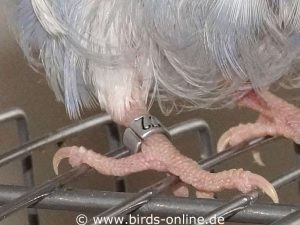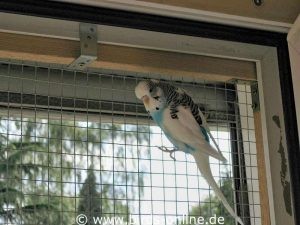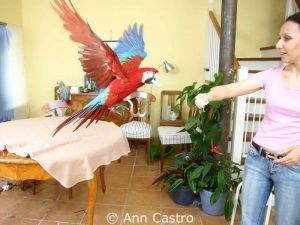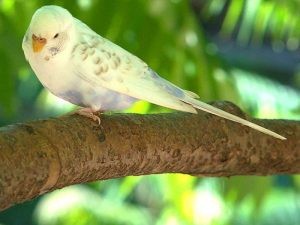Can A Pet Budgie Survive In The Wild? Absolutely, understanding the survival prospects of your avian companion is essential. At PETS.EDU.VN, we aim to provide comprehensive information on the challenges faced by escaped budgies and how to improve their chances of survival. Discover how to protect your pet parakeet!
1. Understanding the Plight of an Escaped Budgie
The thought of a pet bird flying away is a nightmare for many owners. It happens more often than we like to think. A moment of carelessness or a string of unfortunate events can lead to a bird escaping, leaving owners heartbroken. This guide is designed to help you take immediate and effective action should your budgie ever find itself outside. However, the best strategy is prevention. Let’s explore how to keep your feathered friends safe.
1.1. Preparation is Key
Before anything happens, prepare yourself.
- Photographic Records: Take clear, well-lit photos of your birds from various angles. Store these images where you can quickly access them. These photos are essential for creating flyers or online posts should your bird escape.
- Leg Band Identification: If your bird has a leg band, record the numbers and letters on it. This “ID” can help you prove ownership if someone finds your bird.
1.2. Preventing Escape: A Proactive Approach
Avoiding the escape is the best approach. Here’s how to prevent your bird from flying away:
- Stay Vigilant:
- Never assume your bird won’t fly out, even if it has never tried before.
- A sudden scare or curiosity can drive a bird to escape through an open window or door.
- Secure Openings:
- Anyone who allows birds to fly freely must secure all windows and doors.
- Birds can escape through tiny gaps, so vigilance is paramount.
- Child Safety:
- Always supervise small children around birds.
- Children may unintentionally open doors or windows, allowing a bird to escape.
2. Securing the Environment: Windows, Doors, and Cages
Creating a secure environment is crucial for preventing escapes.
2.1. Window Safety
- Protective Grilles: Install protective grilles on windows, ensuring the bars are close enough together to prevent small birds from slipping through.
- Custom Solutions: Consider contacting aviary professionals for custom-made window grilles that fit perfectly.
2.2. Door Security
- Use Locks: Secure doors with locks to create a barrier between the free-flight area and rooms with open windows.
- Hallway as a Gate: Use a hallway as an intermediary zone to prevent birds from accessing rooms with open windows or doors.
2.3. Balcony Doors
- Lockable Handles: Install lockable handles on balcony doors to prevent accidental openings, especially if you have small children.
- Grilles: While possible, grilles for balcony doors are often impractical; locking the handle is a simpler solution.
2.4. Cage and Aviary Security
- Secure Doors: Ensure cage and aviary doors are securely closed.
- Prevent Falls: Ensure that hanging food trays and bathing boxes cannot fall and create escape routes.
3. Recall Training: Enhancing Safety Through Training
Parrot recall training can significantly improve your bird’s safety.
3.1. The Basics of Recall Training
- Command: Choose a simple command, such as “come here,” and use it consistently.
- Gesture: Pair the command with a gesture, like raising your arm for the bird to land on.
- Expert Advice: Consult parrot behavior experts or trainers for guidance on effective training techniques.
- Home Training: Practice indoors first to build reliability.
3.2. Increasing Difficulty
- Out-of-Sight Training: Practice calling your bird from another room where it cannot see you.
- Voice Association: This helps the bird associate your voice with a safe return, even when it can’t see you.
3.3. Limitations
- Stressful Situations: Even successful recall training may not work outdoors in stressful situations.
- Prioritize Prevention: Always prioritize preventing escape, as training is not a foolproof solution.
4. Understanding Budgie Behavior After Escape
Knowing how budgies behave after escaping can aid in their recovery.
4.1. Natural Nomad Instincts
- Nomadic Behavior: Wild budgies are nomadic, constantly searching for food, water, and nesting sites in large flocks.
- Strong Flight Capability: They have excellent flight capabilities, allowing them to cover long distances.
- Instinctive Behavior: An escaped pet budgie will behave according to these instincts.
4.2. Initial Reactions
- No Attachment: Unlike cats, escaped budgies do not typically stay near their home territory.
- Immediate Flight: They tend to fly in any direction, often moving far from their previous home quickly.
- Initial Perching: Initially, they might perch nearby due to fear, but they often don’t recognize their home from this new perspective.
4.3. Lack of Homing Instinct
- No Safe Homecoming: Budgies lack a homing instinct like carrier pigeons.
- Exploratory Behavior: They explore the surroundings without a specific goal.
- Unpredictable Flight Paths: It’s hard to predict where an escaped budgie will fly.
4.4. Distance Traveled
- Initial Radius: Immediately after escape, a bird might stay within a one-kilometer radius.
- Food Search: They soon start searching for food and moving further away.
- Long Distances: Some have been found up to 50 kilometers away within a few days.
- Flight Capabilities: Even pet budgies can fly great distances unless untrained or overweight.
5. Survival Chances: Factors Influencing a Budgie’s Fate
The survival chances of an escaped budgie depend on several factors.
5.1. Weather Conditions
- Severe Weather: Bad weather, with low temperatures and rain, drastically reduces survival time to just a few days or less.
- Freezing Temperatures: Temperatures below freezing with snow can be fatal overnight.
5.2. Seasonal Factors
- Summer and Autumn: These seasons offer the best chances due to available food and moderate temperatures.
- Natural Food Recognition: Birds that have been fed natural foods like grasses and seeds adapt better.
- Spring: Cold nights and limited food make survival more challenging than in summer or autumn.
5.3. Environmental Risks
- Toxic Substances: Consumption of inedible or harmful substances can lead to poisoning and death.
- Predators: Birds of prey, cats, and other carnivores pose a significant threat.
- Cat Danger: Escaped birds that aren’t afraid of cats are particularly vulnerable.
- Traffic Accidents: Lack of experience with road traffic increases the risk of collisions with vehicles.
5.4. Flock Behavior
- Urban Flocks: In some cities, escaped budgies join flocks in parks or with house sparrows.
- Safety in Numbers: Being part of a flock reduces the risk of predation.
6. Immediate Actions After an Escape
Quick and calm action is crucial if your budgie escapes.
6.1. Initial Observation
- Stay Calm: If the bird is nearby, stay calm and avoid sudden movements that could scare it.
- Soothing Voice: Talk to the budgie in a calming voice to reassure it.
- Lure with Food: Use its favorite food to entice it to come closer.
- Recall Command: If trained, use the recall command.
6.2. Using a Decoy Bird
- Companion Bird: Bring the escaped bird’s mate or another familiar bird outside in a secure cage.
- Attraction: The escaped bird might be attracted to the calls of its companion.
- Careful Retrieval: If the escaped bird approaches the cage, carefully return inside.
- Indoor Capture: Once inside, try to gently catch the escaped bird with your hand or a net.
6.3. Utilizing Bird Calls
- Empty Cage: Place an empty cage outside with food and water.
- Recorded Calls: Play recordings of the bird’s partner or other budgies using a cell phone.
- Download Calls: Record the calls beforehand or download them from the internet for easy access.
6.4. Avoid Harmful Methods
- No Garden Hose: Do not use a garden hose to soak the bird, as the water jet can harm or scare it.
- Ineffective Soaking: Soaking the bird rarely works, as it will likely fly away before being soaked.
7. Systematic Search and Notification
If immediate capture fails, initiate a systematic search.
7.1. Mobilizing Support
- Inform Others: Notify friends and family that your budgie has escaped.
- Search Parties: Enlist help from supporters to search the area.
- Information Spread: Have helpers spread the word to increase awareness.
7.2. Advertisements
- Newspaper Ads: Place advertisements in local daily newspapers and online editions.
- Online Monitoring: Check online classifieds for found bird reports.
7.3. Contacting Authorities
- Animal Shelters: Notify local animal shelters and neighboring towns’ shelters.
- Police and Fire Departments: Contact local police and fire departments in case someone has reported finding a bird.
- Veterinarians and Pet Stores: Reach out to local veterinarians and pet stores, as they might have heard about the escaped bird.
7.4. Flyers
- Strategic Placement: Place flyers near your house and in the surrounding area.
- Photo Inclusion: Include a clear photo of your budgie for easy identification.
- Offer a Reward: Provide a generous reward to incentivize the bird’s return.
7.5. Social Networks
- Facebook Groups: Utilize social networks like Facebook, where people report found or escaped birds.
- Community Assistance: If you are not active on social media, ask a friend or family member to help.
8. Emotional Preparation
The reality is that the chances of recovering an escaped budgie are often slim.
8.1. Realistic Expectations
- Be Prepared: Emotionally prepare for the possibility that you may never see your bird again.
- Low Recovery Rate: Understand that the recovery rate for escaped birds is not high.
8.2. Hope and Persistence
- Stay Positive: Despite the odds, stay positive and continue your search efforts.
- Heartfelt Wishes: Hope for a fortunate reunion with your beloved bird.
9. Essential Tips for Ensuring a Budgie’s Well-being
Besides preventing escapes, ensuring your budgie’s overall well-being involves several key steps.
9.1. Balanced Nutrition
- Quality Diet: Provide a balanced diet consisting of high-quality seeds, fresh fruits, and vegetables.
- Variety: Offer a variety of foods to ensure your budgie receives all necessary nutrients.
- Supplements: Consult with a veterinarian about appropriate supplements to enhance their diet.
9.2. Regular Veterinary Check-ups
- Annual Visits: Schedule annual check-ups with an avian veterinarian.
- Early Detection: Regular check-ups can help detect and address health issues early.
- Vaccinations: Follow the vet’s recommendations for vaccinations and preventive care.
9.3. Safe Environment
- Toxic-Free: Keep your home free from toxins such as aerosols, smoke, and harmful cleaning agents.
- Supervision: Supervise your budgie during free-flight time to prevent accidents.
- Secure Cages: Ensure that the cage is sturdy and free from any hazards.
9.4. Mental Stimulation
- Toys: Provide a variety of toys to keep your budgie mentally stimulated.
- Interaction: Spend time interacting with your budgie daily, offering attention and playtime.
- Training: Engage in positive reinforcement training to challenge their minds.
9.5. Proper Hygiene
- Clean Cage: Clean the cage regularly to prevent the build-up of bacteria and maintain a healthy environment.
- Fresh Water: Provide fresh, clean water daily.
- Bathing: Offer opportunities for bathing to keep their feathers clean.
9.6. Social Interaction
- Companionship: Budgies are social birds and thrive with companionship. Consider keeping them in pairs.
- Human Interaction: If keeping a single budgie, ensure plenty of human interaction to meet their social needs.
9.7. Recognizing Signs of Distress
- Behavioral Changes: Watch for any changes in behavior, such as decreased appetite, lethargy, or aggression.
- Physical Symptoms: Be aware of physical symptoms like ruffled feathers, discharge, or labored breathing.
- Prompt Action: If you notice any signs of distress, seek veterinary care immediately.
10. The Role of PETS.EDU.VN in Pet Bird Care
PETS.EDU.VN is dedicated to providing reliable and comprehensive information to help you care for your pet birds.
10.1. Expert Articles
- In-depth Guides: Access articles covering a wide range of topics, from nutrition to behavior.
- Expert Insights: Benefit from insights from avian veterinarians and experienced bird owners.
10.2. Community Support
- Forums: Participate in community forums to connect with other bird owners.
- Share Experiences: Share your experiences, ask questions, and receive support from fellow enthusiasts.
10.3. Resources and Tools
- Checklists: Utilize checklists to ensure you’re meeting all your bird’s needs.
- Product Reviews: Read reviews of bird products to make informed purchasing decisions.
10.4. Emergency Information
- Quick Guides: Access quick guides for handling common emergencies, such as injuries or illnesses.
- Veterinary Directory: Find a directory of avian veterinarians in your area.
11. Case Studies: Success Stories of Rescued Budgies
Inspiring stories of rescued budgies can provide hope and valuable lessons.
11.1. Case Study 1: Buddy’s Journey
- Escape: Buddy, a three-year-old budgie, escaped during a window cleaning session.
- Search Efforts: The owners posted flyers and used social media, offering a reward.
- Recovery: A neighbor found Buddy three days later, attracted by the flyers.
- Lessons Learned: Emphasizes the importance of quick action and community involvement.
11.2. Case Study 2: Sky’s Adventure
- Escape: Sky, a young budgie, flew out of an open door while the owner was bringing in groceries.
- Search Efforts: The owners contacted local animal shelters and used online classifieds.
- Recovery: Sky was found a week later, 20 kilometers away, and identified by her leg band.
- Lessons Learned: Highlights the effectiveness of leg bands for identification and broad search efforts.
11.3. Case Study 3: Echo’s Rescue
- Escape: Echo, a bonded pair, escaped when their cage door was accidentally left unlatched.
- Search Efforts: The owners used a decoy cage with the remaining budgie, playing familiar sounds.
- Recovery: Echo returned to the cage within hours, drawn by the sounds and companionship.
- Lessons Learned: Showcases the power of using familiar sounds and companionship to lure back escaped birds.
12. Expert Insights: Advice from Avian Veterinarians
Valuable insights from avian veterinarians can help you provide the best care for your budgie.
12.1. Dr. Emily Carter, DVM
- Prevention: “The best way to protect your budgie is to prevent escapes. Double-check all doors and windows before allowing free flight.”
- Nutrition: “A balanced diet is crucial for their health. Ensure they get a mix of seeds, fresh produce, and occasional treats.”
- Health Monitoring: “Regular check-ups can catch underlying health issues early. Watch for changes in behavior or appearance.”
12.2. Dr. James Oliver, DVM
- Immediate Action: “If your budgie escapes, act quickly. Use familiar sounds and food to lure them back.”
- Community Support: “Inform your neighbors and local shelters immediately. The more people looking, the better.”
- Safety: “Ensure your home is free from hazards. Budgies are curious and can get into trouble quickly.”
12.3. Dr. Sarah Miller, DVM
- Recall Training: “Start recall training early. It can be a lifesaver if your budgie gets outside.”
- Mental Stimulation: “Keep them mentally stimulated with toys and interaction. A bored budgie is more likely to seek escape.”
- Emergency Preparedness: “Have a plan in place for emergencies. Know where the nearest avian vet is and have a transport cage ready.”
13. Frequently Asked Questions (FAQ) About Budgie Survival in the Wild
Here are some common questions about budgie survival in the wild:
- What are the main dangers for a budgie that escapes into the wild?
- Escaped budgies face dangers such as predators (cats, birds of prey), starvation due to unfamiliarity with local food sources, harsh weather conditions, and traffic accidents.
- How long can a budgie survive in the wild without human assistance?
- Survival time varies. In favorable conditions (summer/autumn, mild weather, access to food), they might survive for several weeks. In harsh conditions (winter, cold weather), survival may be limited to a few days or even hours.
- Can a budgie find food and water in the wild?
- Budgies can find food, especially during summer and autumn when seeds, berries, and other natural foods are abundant. Access to clean water sources is also crucial.
- Is it possible for a budgie to adapt to a wild environment?
- Adaptation is possible, especially for budgies familiar with natural foods. Joining a flock of other birds (like sparrows) can increase their chances of survival.
- What should I do immediately if my budgie escapes?
- Stay calm, observe where the bird flies, and try to lure it back with familiar sounds, favorite foods, or a decoy bird in a cage.
- Should I try to catch my budgie if it’s perched high in a tree?
- Avoid actions that might scare the bird further away. Instead, focus on luring it down with food or familiar sounds.
- How can I make my garden more attractive to an escaped budgie?
- Provide a safe environment with food (seeds, fruits), water, and shelter (bushes, trees).
- What resources can help me find my escaped budgie?
- Contact local animal shelters, veterinarians, and use social media platforms to spread the word. Flyers with a photo and contact information can also be effective.
- Is it common for escaped budgies to be found and returned?
- Recovery rates vary, but the chances increase with quick action and community involvement. Clear identification (leg bands) also helps.
- What are the long-term health implications for a budgie that has spent time in the wild?
- After recovery, a vet check is essential to address potential issues such as parasites, infections, injuries, or malnutrition.
14. Actionable Checklist: What to Do If Your Budgie Escapes
Here’s a comprehensive checklist to guide you through the critical steps if your budgie escapes:
Immediate Actions (First 1-2 Hours)
- [ ] Stay Calm: Avoid panicking to prevent further scaring the bird.
- [ ] Observe: Note the direction the budgie flew and any nearby perching spots.
- [ ] Lure with Familiar Sounds: Play recordings of the budgie’s calls or its favorite music.
- [ ] Offer Favorite Foods: Place the budgie’s favorite treats near the open cage or perch.
- [ ] Use a Decoy Bird: If possible, place the budgie’s companion in a secure cage outside.
- [ ] Inform Household Members: Ensure everyone in the house is aware and assisting.
Short-Term Actions (First 24 Hours)
- [ ] Expand Search Area: Check nearby trees, bushes, and gardens.
- [ ] Notify Neighbors: Ask neighbors to check their properties and report any sightings.
- [ ] Create Flyers: Prepare flyers with a clear photo, description, and contact information.
- [ ] Post on Social Media: Share information on local community groups and pet recovery pages.
- [ ] Contact Local Shelters: Notify local animal shelters and humane societies.
- [ ] Alert Veterinarians: Inform local avian veterinarians.
Mid-Term Actions (Days 2-7)
- [ ] Distribute Flyers: Post flyers in local parks, pet stores, and community centers.
- [ ] Monitor Online Listings: Check online classifieds and lost pet websites.
- [ ] Visit Shelters: Physically visit local animal shelters to look for the budgie.
- [ ] Contact Media: Consider contacting local media outlets to spread awareness.
- [ ] Continue Monitoring: Remain vigilant and continue monitoring all leads.
Long-Term Actions (After 7 Days)
- [ ] Don’t Give Up: Continue to check online resources and visit shelters periodically.
- [ ] Maintain Contact: Keep in touch with local shelters and veterinarians.
- [ ] Evaluate Prevention Measures: Assess how the escape occurred and improve prevention strategies.
Checklist for Prevention
- [ ] Secure Windows and Doors: Ensure all openings are properly secured.
- [ ] Supervise Free Flight: Always supervise budgies during free flight.
- [ ] Train Recall: Teach the budgie to respond to a recall command.
- [ ] Use Identification: Ensure the budgie has proper identification (leg band or microchip).
- [ ] Regular Health Checks: Maintain regular veterinary check-ups.
15. Latest Advances in Budgie Care and Safety
Stay informed about the latest developments in budgie care to ensure their safety and well-being.
15.1. Advanced Nutrition
- Pelleted Diets: High-quality pelleted diets provide balanced nutrition and reduce selective feeding.
- Example: Harrison’s Bird Foods and Roudybush are popular brands recommended by avian vets.
- Superfood Supplements: Incorporating superfoods like chia seeds, spirulina, and kale can boost nutrient intake.
- Benefits: These supplements are rich in antioxidants, vitamins, and minerals that support overall health.
15.2. Enhanced Safety Measures
- GPS Tracking: Miniature GPS trackers can be attached to budgies to monitor their location.
- Benefits: Provides real-time tracking in case of escape, improving recovery chances.
- Improved Cage Designs: Cages with enhanced security features, such as double-locking mechanisms and tighter bar spacing, prevent escapes.
- Smart Home Integration: Integrating bird care with smart home technology can automate environmental controls (lighting, temperature) for optimal health.
15.3. Veterinary Medicine
- Advanced Diagnostics: Modern veterinary diagnostics like CT scans, MRIs, and genetic testing enable more accurate and early detection of diseases.
- Minimally Invasive Surgery: Techniques like laparoscopy and endoscopy reduce recovery time and improve outcomes.
- Behavioral Therapies: Avian behaviorists offer tailored therapies to address behavioral issues, reducing stress and improving quality of life.
15.4. Enrichment and Cognitive Stimulation
- Interactive Toys: Puzzle toys and foraging toys stimulate cognitive function and prevent boredom.
- Example: Toys that require budgies to solve a problem to access a treat.
- Virtual Interaction: Apps and devices that allow remote interaction with budgies through video calls and automated treat dispensers.
- Environmental Enrichment: Rotating toys, introducing new perches, and providing different textures keep budgies engaged and prevent boredom.
15.5. Preventative Health Care
- Probiotics: Regular use of probiotics supports gut health and boosts the immune system.
- Benefits: Helps prevent digestive issues and enhances nutrient absorption.
- Air Purification: High-efficiency particulate air (HEPA) filters remove airborne toxins and allergens, improving air quality and respiratory health.
- UV Lighting: Providing full-spectrum UV lighting mimics natural sunlight, promoting vitamin D synthesis and improving mood.
Table: Latest Advances in Budgie Care and Safety
| Category | Advance | Description | Benefits |
|---|---|---|---|
| Nutrition | Pelleted Diets | Balanced nutrition in every bite, reducing selective feeding. | Ensures complete nutrient intake, reducing health issues. |
| Superfood Supplements | Addition of nutrient-rich superfoods like chia seeds and spirulina. | Boosts antioxidant levels, improves overall health and vitality. | |
| Safety | GPS Tracking | Miniature GPS trackers attached to budgies. | Real-time location tracking in case of escape, increasing recovery chances. |
| Improved Cage Designs | Cages with double-locking mechanisms and tighter bar spacing. | Prevents escapes and enhances safety. | |
| Veterinary Medicine | Advanced Diagnostics | Utilization of CT scans, MRIs, and genetic testing. | Accurate and early disease detection. |
| Minimally Invasive Surgery | Techniques like laparoscopy and endoscopy. | Reduced recovery time and improved outcomes. | |
| Enrichment & Stimulation | Interactive Toys | Puzzle toys and foraging toys. | Stimulates cognitive function and prevents boredom. |
| Virtual Interaction | Apps for remote interaction with budgies. | Provides stimulation and companionship when owners are away. | |
| Preventative Health Care | Probiotics | Regular use of probiotics. | Supports gut health and boosts the immune system. |
| Air Purification | HEPA filters for removing airborne toxins. | Improves air quality and respiratory health. | |
| UV Lighting | Full-spectrum UV lighting. | Promotes vitamin D synthesis and improves mood. |






By staying informed and incorporating these latest advances, you can significantly enhance your budgie’s safety, health, and overall quality of life.
Escaped budgies face numerous challenges in the wild. But with preparation, knowledge, and quick action, you can increase their chances of survival and recovery. Visit PETS.EDU.VN for more expert advice and resources to ensure the well-being of your feathered friends. Need more personalized advice or services? Contact us at 789 Paw Lane, Petville, CA 91234, United States, Whatsapp: +1 555-987-6543, or visit our website at pets.edu.vn.